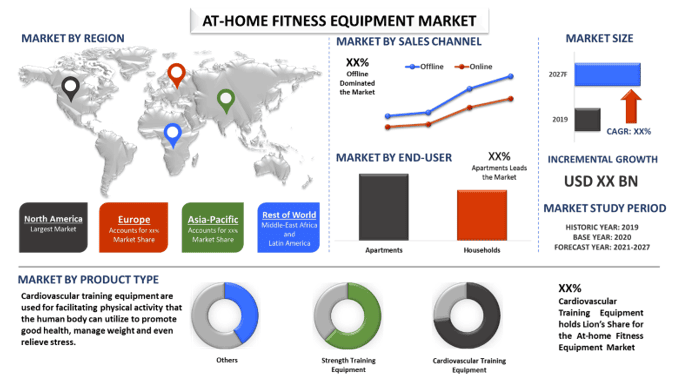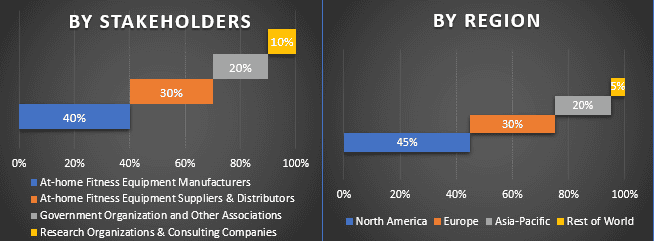- Home
- About Us
- Industry
- Services
- Reading
- Contact Us
At-Home Fitness Equipment Market: Current Analysis and Forecast (2021-2027)
Emphasis on Product Type (Cardiovascular Training Equipment, Strength Training Equipment, Others); Sales Channel (Online, Offline); End-Use Type (Households, Apartments); Region/Country

Global At-home Fitness Equipment Market was valued at US$ 5.92 billion in 2020 and is anticipated to reach US$ 8.24 billion by 2027 displaying an elevated CAGR of 4.97% over the forecast period (2021-2027). At-home fitness equipment is any apparatus or machine used for physical activity by the consumer at the comfort of their home in order to enhance their muscular strength to remain fit and helps them in managing their body weight.
With the rising number of working professionals and the problems faced by some fitness enthusiasts due to their busy schedules and long working hours, many of the consumers are actively adopting home workout routines which in turn is propelling the market growth. Also, the growing trends of home workouts are providing a boost to home workout equipment sales as more consumers are spending on these products. For instance, in the UK, nearly 53% of the consumers spend an average of USD 218 each on buying home workout products in the last year.
The worldwide demand for home equipment is escalating due to the increase in the global burden of people suffering from chronic diseases including cancer, heart diseases, and diabetes that has inclined people to adopt a healthy lifestyle which will drive the global market of at-home fitness equipment. For instance, according to WHO, 41 million people die every year because of non-communicable diseases accounting for 71% of all deaths all over the world. Furthermore, exercise equipment is gaining huge popularity among fitness enthusiasts owing to the growing trend of bodybuilding which in turn is boosting the market growth. However, some of the restraints in the market include the various alternatives available for home workouts. Moreover, the installation and requirement of other services have caused an increase in cost for set up and service charges of at-home fitness equipment which in turn is impeding the growth of the market.
Number of People Purchasing Exercise Equipment, Great Britain, By Expenditure, 2018-2020 (in thousands)

Icon Health & Fitness Inc., Core Health & Fitness LLC, Johnson Health Tech Co. Ltd., Decathlon, Technogym SpA, Nautilus Inc., Echelon Fitness Multimedia LLC, TRUE Fitness, Dyaco International Inc., Rogue Fitness are some of the prominent players operating in the at-home fitness equipment market. Several M&As along with partnerships have been undertaken by these players to facilitate customers with new and innovative equipment.
Insights Presented in the Report
“Amongst Product Type, cardiovascular training equipment segment holds the major share”
Based on product type, the market is fragmented into cardiovascular training equipment, strength training equipment, and others. The cardiovascular training equipment segment generated highest revenue in 2020 and is expected to grow remarkabally during the forecast period to reach lead the market by 2027F as there is an increased awareness among the consumers about their cardiovascular health. Further, this segment is also sub-segmented into treadmills, elliptical machines, stationary cycles, and rowing machines. Among these, the stationary cycles segment grabbed a considerable market share of the at-home fitness equipment market in 2020.
“Amongst Sales Channel, offline segment holds the major share”
Based on the sales channel, the market is fragmented into online and offline. The offline segment garbbed the major market share and dominated the marKet and is expected to grow at skyorocketed CAGR during the forecast period due to the presence of a large number of fitness stores and the presence of the expert who aids in guiding the consumer for buying specific product according to their requirement and needs. However, the online segment is also anticipated to grow at a considerable CAGR during the forecast period.
“Amongst End-User, Apartments segment holds the major share”
Based on the end-user, the market is fragmented into households and apartments. The apartments segment grabbed the leading market share in 2020 and is expected to grow at a astonished CAGR during the forecast period. The growth of this segment is attributed to the emerging trends of constructing gyms in apartments in the majority of the countries. For instance, as per a 2020 survey conducted among 2,000 renters in the U.S., nearly 29% of the respondents stated that gym or recreational sports facilities in the apartment are the most important home amenities to them. However, the household segment is expected to grow at a significant pace in the upcoming years.
“North America represents one of the largest markets of at-home fitness equipment market”
For a better understanding of the market dynamics of the at-home fitness equipment market, a detailed analysis was conducted for different regions across the globe including North America (the U.S, Canada, and the Rest of North America), Europe (Germany, France, Spain, United Kingdom, Italy, and Rest of Europe), Asia-Pacific (China, Japan, India, Australia, and Rest of APAC), Rest of World has been conducted. North America dominated the market in 2020 owing to to rising preventive healthcare measures many consumers are engaging in regular workout regimes to remain fit. However, Asia-Pacific is also expected to grow at a significant CAGR during the projected timeframe.
Reasons to buy this report:
- The study includes market sizing and forecasting analysis validated by authenticated key industry experts
- The report presents a quick review of overall industry performance at one glance
- The report covers an in-depth analysis of prominent industry peers with a primary focus on key business financials, product portfolio, expansion strategies, and recent developments
- Detailed examination of drivers, restraints, key trends, and opportunities prevailing in the industry
- The study comprehensively covers the market across different segments
- Deep dive regional level analysis of the industry
Customization Options:
The global at-home fitness equipment market can further be customized as per the requirement or any other market segment. Besides this, UMI understands that you may have your own business needs, hence feel free to connect with us to get a report that completely suits your requirements.
Table of Content
Analyzing the historical market, estimation of the current market, and forecasting the future market of the Global At-home fitness equipment market were the three major steps undertaken to create and analyze the adoption of At-home fitness equipment in major regions globally. Exhaustive secondary research was conducted to collect the historical market numbers and estimate the current market size. Secondly, to validate these insights, numerous findings and assumptions were taken into consideration. Moreover, exhaustive primary interviews were also conducted, with industry experts across the value chain of the global at-home fitness equipment market. Post assumption and validation of market numbers through primary interviews, we employed a top-down/bottom-up approach to forecasting the complete market size. Thereafter, market breakdown and data triangulation methods were adopted to estimate and analyze the market size of segments and sub-segments the industry pertains to. Detailed methodology is explained below:
Analysis of Historical Market Size
Step 1: In-Depth Study of Secondary Sources:
Detail secondary study was conducted to obtain the historical market size of the at-home fitness equipment through company internal sources such as annual report & financial statements, performance presentations, press releases, etc., and external sources including journals, news & articles, government publications, competitor publications, sector reports, third-party database, and other credible publications.
Step 2: Market Segmentation:
After obtaining the historical market size of the at-home fitness equipment market, we conducted a detailed secondary analysis to gather historical market insights and share for different segments & sub-segments for major regions. Major segments included in the report as product type, sales channel, and end-user. Further country-level analyses were conducted to evaluate the overall adoption of at-home fitness equipment across the globe.
Step 3: Factor Analysis:
After acquiring the historical market size of different segments and sub-segments, we conducted a detailed factor analysis to estimate the current market size of the at-home fitness equipment. Further, we conducted factor analysis using dependent and independent variables such as the increasing disposable income and rising urban population. A thorough analysis was conducted for demand and supply-side scenarios considering top partnerships, merger and acquisition, business expansion, and product launches in the at-home fitness equipment sector across the globe.
Current Market Size Estimate & Forecast
Current Market Sizing: Based on actionable insights from the above 3 steps, we arrived at the current market size, key players in the at-home fitness equipment market, and market shares of the segments. All the required percentage shares split, and market breakdowns were determined using the above-mentioned secondary approach and were verified through primary interviews.
Estimation & Forecasting: For market estimation and forecast, weights were assigned to different factors including drivers & trends, restraints, and opportunities available for the stakeholders. After analyzing these factors, relevant forecasting techniques i.e., top-down/bottom-up approach was applied to arrive at the market forecast about 2027 for different segments and subsegments across the major markets globally. The research methodology adopted to estimate the market size encompasses:
- The industry’s market size, in terms of value (US$) and the adoption rate of at-home fitness equipment across the major markets domestically
- All percentage shares, splits, and breakdowns of market segments and sub-segments
- Key players in the at-home fitness equipment market in terms of products offered. Also, the growth strategies adopted by these players to compete in the fast-growing market
Market Size and Share Validation
Primary Research: In-depth interviews were conducted with the Key Opinion Leaders (KOLs) including Top Level Executives (CXO/VPs, Sales Head, Marketing Head, Operational Head, and Regional Head, Country Head, etc.) across major regions. Primary research findings were then summarized, and statistical analysis was performed to prove the stated hypothesis. Inputs from primary research were consolidated with secondary findings, hence turning information into actionable insights.
Split of Primary Participants in Different Regions

Market Engineering
Data triangulation technique was employed to complete the overall market estimation and to arrive at precise statistical numbers of each segment and sub-segment of the at-home fitness equipment market. Data was split into several segments & sub-segments post studying various parameters and trends in the areas of product type, sales channel and end-user of the at-home fitness equipment market.
The main objective of the At-home Fitness Equipment Market Study
The current & future market trends of at-home fitness equipment were pinpointed in the study. Investors can gain strategic insights to base their discretion for investments from the qualitative and quantitative analysis performed in the study. Current and future market trends were determined the overall attractiveness of the market at a regional level, providing a platform for the industrial participant to exploit the untapped market to benefit as a first-mover advantage. Other quantitative goals of the studies include:
- Analyze the current and forecast market size of At-home fitness equipment in terms of value (US$). Also, analyze the current and forecast market size of different segments and sub-segments
- Segments in the study include areas of product types, sales channel and end-user
- Define and analysis of the regulatory framework for the At-home fitness equipment industry
- Analyze the value chain involved with the presence of various intermediaries, along with analyzing customer and competitor behaviors of the industry
- Analyze the current and forecast market size of the At-home fitness equipment market for the major region
- Major regions studied in the report include North America, Europe, Asia-Pacific and Rest of the world
- Company profiles of the At-home fitness equipment market and the growth strategies adopted by the market players to sustain in the fast-growing market
- Deep dive regional level analysis of the industry
Related Reports
Customers who bought this item also bought










